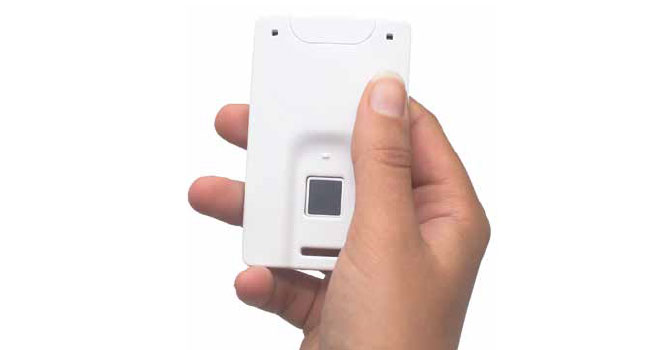
Using Present Card Readers, Organizations Can Now Easily Add Biometrics
Without having to change out an organization’s existing readers, the biometric card provides an easy, low cost way for facilities to provide a biometric upgrade
- By Kim Humborstad
- Jan 01, 2015
More and more, security professionals
using card-based front
ends for their access control systems
have been worried about
the security of their proximity
systems. They know that for $200 or less, their proximity
system can be violated.
A convenient way to establish higher security within
certain areas of a building is an appealing idea to
many security directors. Whether it is to more highly
secure the pharmacy lab at a hospital, the laboratory
at a government research facility or the tarmac at a
small airport, some locations simply need to have
more scrutiny paid to who is entering. Going beyond
the card only—something they carry—and adding
a PIN—something they know, many organizations
employ multi-factor authentication at such locations.
But, even that is done irregularly as this often means
a different reader is needed. Yet even when this is undertaken,
somebody else can use still use another employee’s
card and PIN.
Only biometrics provides the solution for authenticating
“who” is at the door. In the perfect world
of large budgets, facilities would have a biometrics
reader at every door that would need higher security.
Of course, that would mean ripping out the present
card readers and having to budget the money for new
biometric readers plus the make the investment of
making sure that the biometric integrates into their
present access control system.
Some suggest that this can be done with a smart
card. After all, the multi-application flexibility of
contactless smart cards lets a facility use them for logical/
information access control, time and attendance
and other applications in addition to physical access
control. Each application gets its own memory space
on the card or tag and security keys prevent one application
from accessing another. For those considering
biometrics at some of their access points, the card can
even hold the biometric template.
Nonetheless, there still remains a problem with the
smart card. Who is presenting the smart card to the
reader? The system doesn’t know. All it can understand
is that an authorized card has been presented to
the reader. Thus, the door should open, respective of
who is holding the card.
Yet, a biometric template carried within the card
could help solve that problem, but at what expense?
To do so, it still needs a biometric reader, an additional
piece of hardware, raising the infrastructure cost
to do what the card should be doing in the first place:
verifying who is trying to enter.
Why Not Put Biometrics
Directly on the Smartcard?
There would be no additional hardware to buy and
the proximity or smart card wouldn’t work unless
verified by the authorized person’s thumbprint on the
card. With a biometric card, the facility would reap all
of the security and access control advantages of the
smartcard plus biometrics.
That solution is now available. A contactless card
credential, which works with proximity and/or smart
card readers, with on-card fingerprint reading is available
to provide all the assets of the card and eliminate
its most glaring deficiency, not knowing who is holding
it. The biometric card quickly reads the user’s fingerprint
in less than a second.
Eliminating the problems of solely deploying PINs
and standard cards, the wirelessly powered biometric
card lets users authenticate themselves directly on
the card through something they are, a fingerprint or
thumbprint. Only then will the card system activate
the lock. This is much more secure than simply using
a standard card, which verifies only something the
user carries.
An on-card fingerprint scanner with 3D capacitive
technology resides on the contactless smart card
which has universal compatibility with all ISO 14443
readers from the leading brands. The biometric card
is DESFIRE EV1 and MIFARE Classic compatible.
Without having to change out an organization’s existing
readers, the biometric card provides an easy,
low cost way for organizations to provide a biometric
upgrade to access control systems using proximity or
smart card readers.
Thus, the biometric card is more secure to use than
other available ID and authentication solutions on
the market today. The fingerprint data is captured by
the on-card fingerprint scanner and is thereafter encrypted
and stored only inside the card. No exchange
of data is conducted with external systems. This
provides secure template management since the fingerprint
never leaves the card. It also eliminates user
concerns with privacy issues.
The card is unique to the user and only the authorized
card holder can activate card communication
with the reader. When a positive match occurs, the
biometric card activates encrypted communication
with the lock or reader in the same way as other ISO
14443 contactless proximity or smart cards.
Problem Solved
No longer do security administrators need to worry
if someone not authorized to enter is using another
person’s ID card. With the biometric
directly on the card, they can
be assured that the only people
getting in are those authorized to
do so.
This article originally appeared in the issue of .